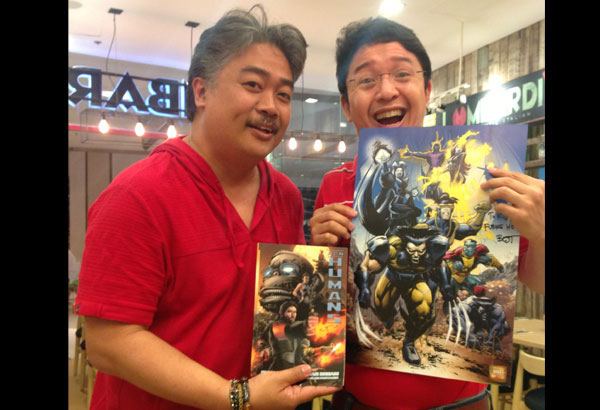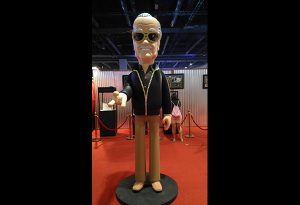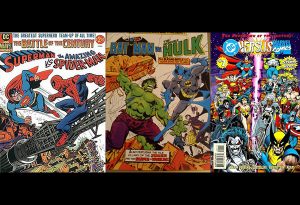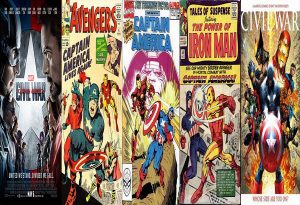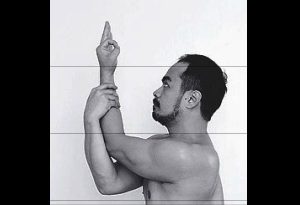Fil-Am standup comic Rex Navarette got it right: For every great superhero team, there is always a great Pinoy working behind the scenes.
And one of those great Pinoys who has worked in the X-Men’s Danger Room, tinkered with Iron-Man’s armor, and played with Batman’s utility belt is rock star Fil-Am comic book artist Whilce Portacio, who has worked behind some of the most popular franchise comic book characters from Marvel and DC which include X-Men, X-Factor, Iron-Man, Punisher and Batman.
On top of his creative work on the “Big Two,” Whilce was one of seven comic book artists who “jumped ship” from Marvel to put up an independent comic book company called Image Comics — where they could retain ownership and creative control over their own superhero creations. Through Image Comics, Whilce released two creator-owned comics called Wetworks (who had a character that was a Philippine Army Scout Ranger) and Stone (a comic book that was steeped in Filipino mythology).
In an exclusive interview with The Philippine STAR when he visited the country over the Holidays, Whilce shared not only how he hid Pinoy “Easter eggs” in his work, but also the creative process in creating the X-Men character Bishop (who will be appearing in the next X-Men movie) and his two creator-owned properties Wetworks and Stone.
Close Ad X
ON PINOY EASTER EGGS
PHILIPPINE STAR: I recall that you would have a little fun with your readers by dropping “Pinoy Easter eggs” (or, in this case, balut eggs) into your artwork. And when Pinoy readers spotted those little tributes, we were so thrilled by them that we happily soiled our X-Men character underwear.
WHILCE PORTACIO: (Laughs) It really started as a communication tool. I wanted to see if (the readers) were paying attention and if I could communicate with them. When I drew Uncanny X-Men, I had a bomber leather jacket that had a Philippine flag and my nickname “Makulit” (emblazoned at the back of the jacket). I drew that jacket on Colossus (a popular X-Men character) to see what would happen. Then when I went to (comic book) conventions, not only Pinoys but also Mexicans, Caucasians, African-Americans, they came up to me and try to pronounce “Makulit.” (Laughs)
Makulit became a self-fulfilling prophecy.
I drew Regine (Velasquez) as a news reporter in (Marvel Comics) and a lot of people picked up on that as well. Then came my ultimate (Easter egg). I had a character (of Filipino ethnicity) called “Grail” (in a comic book he created called Wetworks) who was surprised by a vampire that was coming up from behind him. I wondered “What would happen if he turned around and reacted like a Filipino?” So I made him say “Susmaryosep!”
There are other Pinoy phrases I might have probably used if I caught a vampire sneaking up behind me.
(Laughs) Since I had control over this comic, I made the decision that I wouldn’t (provide a translation of this word into English). You don’t know how many kids at conventions came up to me and murdered that phrase. (Laughs) But the point was that we were communicating (with our readers).
If my yaya were in Wetworks, she would use a litany of Ilonggo cuss words to take down those vampires.
ON BISHOP
You’ve also contributed to the X-Men mythology by creating the African-American X-Man called “Bishop” — a military style-X-Man from a bleak future where mutants are hunted down by humans. In fact, Bishop will be appearing in the upcoming X-Men: Days of Future Past movie. Please share with us what was the creative process that went into creating a new X-Man.
Bob Harras (the editor of the X-Men books at that time and now the current editor in chief of rival DC Comics) told me that there were talks to split up the X-Men team into two groups (who would be featured in two different comics). I wanted to stay on the X-Men book where I would draw the old team (consisting mostly of the founding characters of the X-Men created by Stan Lee and Jack Kirby which included Jean Grey, Iceman and Angel). But accounting came in and said that there was a “perception” that the X-Men team (I was drawing) was “weaker” because Wolverine (who was über-popular among readers at that time) was not on his team. Bob called me and asked me to come up with a new X-Men character. Being a creative person, I asked, “What were the parameters of the character?” He said, “Just make sure everybody reacts to him.”
I didn’t realize just how much accounting could drive creativity.
I took this as a challenge. I dissected every single character in my X-Men team, analyzed their personality types and tried to figure out what kind of character I could introduce that would make all of them react. After all that, I ended up with a character from the “Days of Future Past” X-Men storyline (the storyline that became the inspiration for the upcoming X-Men movie). He was a survivor who lived in a harsh world, who killed because if he didn’t kill, then he wouldn’t survive. However, this character was initially too close to Wolverine. So to make him different, I realized that he only killed out of “practicality” or else he would die in his world. If he were taken out of his “harsh world” and placed in a more peaceful environment, he would be this nice, cool, suave guy. Not this angry, brooding character like Wolverine. That type of character fit in with all the others.
Parang FPJ lang pala si Bishop. ‘Sorry I had to kill you, walang personalan, trabaho lang.’
The name Bishop came from our former studio assistant Karl Alstaetter (who is now a top toy designer at Mattel). Karl was like our “bishop” when people wanted to get through to me or my (former studiomate) Jim Lee. He was around 17 years old at the time and he helped us keep in touch with our target market. After I had designed Bishop’s military uniform, Karl suggested that I put Jheri curls on the character. (I was reluctant to do so at first), but when we “tested” the character on people, they didn’t react to the hairstyle. In fact, people who sported Jheri curls in the ‘70s but were afraid to do so now because it was considered passé used Bishop as a justification to say that Jheri curls would come back in the future! (Laughs)
ON ‘WETWORKS’
Pinoy comic book fans went into a collective geekgasm when you created the comic book Wetworks back in 1992 for (then upstart) Image Comics — a company you helped found. Wetworks — about black operative soldiers who were bonded to golden symbiote armor and battled supernatural forces — was probably the first ever Filipino-American comic book creation that also had a Filipino as one of its main characters. How did you create Wetworks?
I co-wrote Wetworks with Brandon (Choi, who also co-wrote another original comic book with Korean-American Jim Lee called WildCATS for Image Comics). (Being a US navy brat), I have a military background and I wanted to do a military book. I was never really enamored with superhero powers that made them better than the normal person. So (my creative process) started with “How can humans compete in that world (of super-powered beings)? And, if so, who are the best human specimens to compete?” Arguably, those would be special operations, specifically the Navy SEALS. So the next step was to find out “How would Navy SEALS be able to fight superheroes?” I asked a military adviser who was actually a part of SEAL Team 6 what would be the “gift of God” for Navy SEALS. He answered it would be “armor that could move with you.” At that time, Terminator 2 had just come out, which made me think, “What if there was liquid armor?”
As opposed to cosplay armor.
Finally, these superheroes had to fight supervillains. But I didn’t want to have to constantly create all these new supervillains to battle a team of superheroes. (Given this), my co-writer Brandon — who had a law background — had the idea of using “supernatural” monsters such as vampires and Frankenstein (as the supervillains) in the book because their intellectual property rights were now public (domain)! So there were now hordes of monsters for them to fight! (As you can see), it was really a process that came about from myself wanting to do military stuff.
ON ‘STONE’
Stone, a comic book which you co-created with Brian Haberlin (the co-creator of popular comic book character Witchblade), was the first international comic book that dealt heavily with elements of Filipino mythology. How did you bring this comic into the mainstream of the US publishing industry?
Stone started out back in 1995. I had already built my reputation in the comic book industry after being in the business for 16 years. I was living a nice bachelor life and came back to the Philippines to try new media. As I was gathering a local team of great artists (which included Leinil Yu, Gerry Alanguilan, Philip Tan, Gilbert Monsanto, Jay Anacleto, Ray Allan Martinez, Edgar Tadeo, Ryan Orosco) I wanted to try a Pinoy-centric concept. Gerry pushed me to try to do this locally so that we could kickstart the local publishing industry. After I drew 10 pages of this Pinoy-centric comic (which was the original version of Stone), Brian Haberlin, who wanted to go independent (from the two large publishers DC and Marvel), saw the artwork and encouraged me to build up the local art studio (I put together) into a full studio and to actually start publishing comics. He also recommended that we change the comic from a local to an international setting.
So that explains why the comic read like it was supposed to be set in the Philippines, but somehow it wasn’t in the Philippines at the same time.
Originally, it was going to be this pure Filipino story where we didn’t have to set up (the back story) of manananggals and tikbalangs. But since the comic was now aimed for an international market, we had to explain these local supernatural creatures. When we launched Stone, it was the number one independent book selling 77,000 copies (at the time, the highest independent comic book not published by DC and Marvel was 30,000). We hit a mark and everybody started liking it. Then Wally Chamsay, who was president of Sony Music Philippines at that time and a fan, contacted me and asked if I wanted to come up with a Stone album! We launched Stone with an album that included Andrew E, Razorback and Wolfgang. It turned out from that deal that Wally was trying to pitch Stone as a franchise for Sony to purchase. The pitch for Stone went up through all of Sony’s divisions — gaming, entertainment, TV, toys — until it reached the top of the checklist: movies. But a week after flying into Los Angeles to meet with Sony executives, we got word that they turned it down because Jackie Chan had the same concept (which turned out to be the Jackie Chan Adventures cartoon).
So Jackie Chan inadvertently kung-fu’d Stone’s international debut? Susmaryosep. Will we ever see the conclusion to Stone’s adventure anytime soon?
Brian and I have decided to collect all the old issues into a trade paperback after which we’re going to launch a new series. I’m not sure if I’m going to draw that, I might art-direct a new team from here (in the Philippines)!
We’re looking forward to getting Stoned again.
